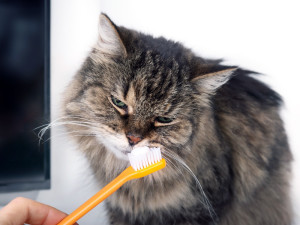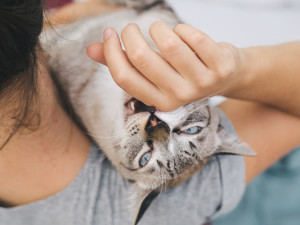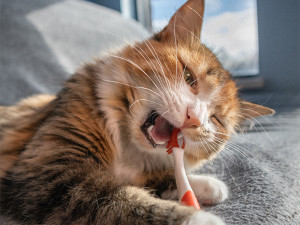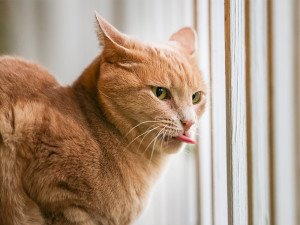Dental Disease in Cats: Signs to Watch Out For and Prevention Tips
Much to their disappointment, taking care of your cat’s teeth is essential.
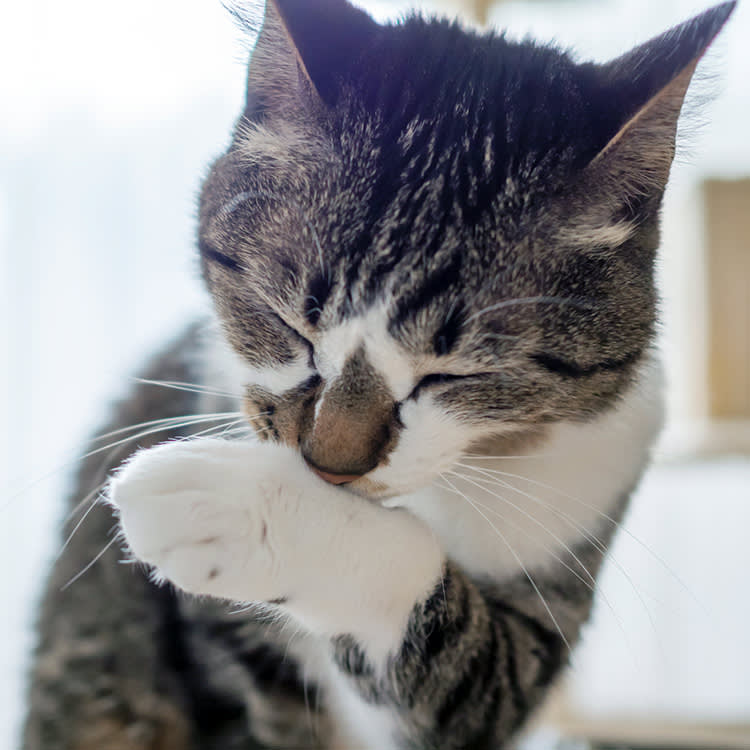
Share Article
In This Article:
Symptoms of Dental Disease in Cats Causes and Disease Progression Associated Health Risks of Dental Disease in Cats Preventative Care Treatment Options Frequently Asked Questions
Dental disease in cats stems from a buildup of plaque and tartar on the teeth, causing inflamed gums, bad breath, and loose or infected teeth. Dental disease in cats not only causes tooth loss but may be associated with kidney, liver, and heart problems down the road.
Symptoms of dental disease in cats
You may not spend much time thinking about your cat’s teeth until they’re yawning in your face and you catch a whiff of some very offensive breath. Even for cats, eau de rotting fish is never a good look. Bad breath is just one sign that something may be up with your cat’s teeth.
Some other common symptoms of dental disease in cats include:

Red, inflamed gums
Pain when chewing (turning head while eating)
Swallowing food whole
Decreased appetite
Discolored teeth
Dropping food when eating
Bloody saliva
Teeth chattering
Loose or missing teeth
Facial swelling
Nasal discharge
The signs of dental disease in cats can be subtle. Cats are great at hiding discomfort from their parents. Dental problems may be severe before you notice that something’s off, especially if you’re not brushing your cat’s teeth regularly.
Cats can develop problems with their teeth due to a number of different diseases, but all dental issues have the potential to impact your kitty’s overall health and cause significant discomfort.
Causes and disease progression
It’s often impossible to know what causes dental disease in cats just from looking externally. Your veterinarian can get an initial idea about the severity of dental disease from a routine physical examination, but examination under anesthesia with dental radiographs is vital to discovering the full extent of the damage and its possible cause.
There’s a lot of overlap in symptoms between different types of dental disease, but some conditions require more than a simple cleaning to manage. Some common causes of dental disease in cats include:
Gingivitis
Gingivitis is inflammation of the gums around the teeth and is one of the earliest signs of dental disease in cats. A cat’s gums most commonly become inflamed due to contact with plaque and tartar on the teeth. Plaque is a biofilm (kinda like a bacterial slime) that coats teeth. Plaque can harbor good bacteria that help with oral health, but a buildup of plaque along and beneath the gum line can lead to problems.
If it’s not removed, plaque begins to mineralize within hours and can develop into tartar (also called calculus) within three days. The hard, roughened surface of tartar provides more area for plaque to stick to and bad bacteria to thrive. The presence of bad bacteria and irritation from the rough tartar lead to gingivitis. Gingivitis causes redness, swelling, pain, and possibly bleeding along the gumline.
Periodontitis
As gingivitis and tartar buildup progress, cats can develop damage to the tissues that hold teeth in place. This weakening of support structures is called periodontitis. Chemicals produced by bad bacteria and the effects of inflammation destroy bone and ligaments around teeth.
This more severe dental disease in cats may result in loosening or loss of teeth, or the need for extraction during a dental cleaning. Keeping unhealthy teeth in the mouth just leads to more pain and problems.
Tooth resorption
Some cats seem to be predisposed to a condition where teeth begin to break down from within. Tooth resorption occurs in many cats, with up to 70 percent affected in some studies. Certain breeds, like Siamese, Persian, Abyssinian, and Russian Blue cats, may be predisposed to this condition.
There may be no external signs of tooth resorption until it has progressed significantly, but dental radiographs can catch it early. Depending on the location of the problem (below or above the gumline) and severity of tooth destruction, your veterinarian may recommend simple monitoring with regular dental care or tooth extraction. The goal when treating tooth resorption is to minimize pain for the cat while maintaining as much function as possible.
Feline chronic gingivostomatitis
Some cats can suffer from a severe, frustrating, and especially painful form of dental disease called stomatitis. Stomatitis refers to inflammation within the mouth, which usually involves the gums, tongue, and cheeks. The causes for this chronic ulcerative condition are still being worked out, but it seems to be due to an inappropriate immune response to plaque.
This is not considered an autoimmune dental disease in cats because the body is reacting to something external—the bacteria found in plaque. The trigger for this dramatic immune response isn’t known, but there are some possible disease associations being researched:
Feline leukemia virus (FeLV) and feline immunodeficiency virus (FIV)
Feline calicivirus
Feline herpesvirus
Oral bacterial infections
Immune-mediated diseases
Nutritional disorders
Cats with chronic stomatitis often have severe dental and oral pain that makes it difficult for them to eat. Medical treatment with drugs to suppress the immune system may help, but full-mouth dental extractions seem to have the most success in defeating this disease. This is obviously a very big step to take, so extensive consultation with your veterinarian and a veterinary dentist is needed.
Associated health risks of dental disease in cats
For most cats, the appreciable effects of dental disease are limited to the mouth. Cats with severe dental disease, dental abscesses, or chronic gingivostomatitis may eat less or stop eating completely, which can lead to fatty liver disease, dehydration, malnutrition, and a variety of other health issues.
There is a long-standing concern that dental disease can affect other organs. This is due to the chronic inflammation that results from dental issues and the bacteria associated with dental disease entering the bloodstream during eating, tooth brushing, and dental work. The link between dental disease and disease in other organs like the kidneys, liver, and heart has been looked into numerous times, but a firm link has yet to be established.
It seems unlikely that dental disease causes heart problems in cats unless they were born with certain serious heart defects. An association between the severity of dental disease and elevation of kidney values has been established, but it’s difficult to know if there’s a cause-and-effect relationship between the two. In general, it’s best to do what you can to prevent dental problems in your cat. That way, you’re keeping their mouth comfortable and minimizing the risk of other diseases.
How to prevent dental disease in cats
Strategies for preventing dental disease in cats require pet parents to put in some effort but should pay off in happier mouths, fresher breath, and fewer serious dental problems. While it may seem daunting initially, preventative dental care can gradually be worked into your cat’s daily routine and become part of their normal relationship with you.
Your veterinarian can best guide you on what’s right for your cat, but some common recommendations to prevent dental problems include:
Tooth brushing at home
It can take a little time to get your cat used to the idea of having their teeth brushed if you weren’t able to acclimate them to it as a kitten. Over a period of weeks, you can incorporate the toothbrush and toothpaste into their playtime with you. It’s a gradual process, but approaching how to brush your cat’s teeth in a slow, stepwise manner can help to keep them comfortable.
Diet, treats, and water additives
The Veterinary Oral Health Council evaluates dental products for dogs and cats to make sure they are appropriate and effective. Their list of accepted products for catsopens in new tab is a good place to start when you’re looking for dental supplements to maintain your cat’s oral health. Work with your veterinarian to determine which approaches are right for your cat.
Regular veterinary cleanings
Your veterinarian can guide you on how frequently your cat needs dental evaluations and cleanings. Many younger cats require annual oral health assessments and treatments, but older cats and cats predisposed to dental disease may need check-ups more frequently.
A dental evaluation and cleaning under anesthesia is the only way to get rid of disease beneath the gum line and check for hidden disease affecting dental health.
Treatment options for dental disease in cats
It’s not your responsibility to know how to treat dental disease in cats, but it is helpful to know what your veterinarian might discuss for certain conditions. Their recommendations will be based on dental radiographs, probing of the gums, and the appearance of your cat’s teeth. Some common strategies for dental disease in cats include:
Dental cleanings
Your veterinarian has specialized equipment to perform dentistry, allowing them to safely remove tartar build-up above and below the gumline and to polish teeth. This type of cleaning can help with gingivitis, bad breath, and dental pain.
Removal of diseased teeth
Periodontitis can cause damage around teeth, causing them to become loose. If the structures holding teeth in place are badly damaged, extraction of the tooth may be recommended. Severely diseased teeth act as a constant source of pain and discomfort, and worsening bone loss can possibly lead to a fracture of the jaw or communication into the nasal cavity. Sometimes taking a tooth out is the best way to prevent future problems.
Tooth repair
Some fractured teeth can be “repaired.” When a tooth breaks, the inner pulp is often exposed, leading to inflammation and infection. For larger teeth, a root canal can be performed if the tooth is healthy enough. In this procedure, all of the tooth pulp is removed to remove infection, then the canal is filled and sealed.
This allows the cat to keep their normal tooth, limiting problems with chewing and lip injury. Root canals are usually performed by veterinary dentists.
Full-mouth dental extractions
For severe cases of chronic stomatitis, full-mouth dental extractions (removal of all of a cat’s teeth) may be the best course of action. While this may seem like a cruel and drastic step, it actually improves the quality of life of the majority of cats that undergo the procedure.
Chronic stomatitis makes cats so miserable that removing the source of the pain completely is often the best way to deal with the problem.
Antibiotics
Antibiotics are not commonly used for routine dental disease in cats because dental infections need to be treated at the source by cleaning teeth, extracting unhealthy teeth, and draining dental abscesses. Antibiotic resistance is a major issue in both animal and human health, so limiting the unneeded use of antibiotics is vital to ensuring that they still work when they’re needed.
FAQs (People also ask):
Can dental disease cause kidney failure in cats?
Dental disease has been associated with increased kidney values in cats, but it has not been established as a cause of kidney failure. Kidney disease in cats has many possible causes, so it can be hard to pinpoint one issue that triggers it.
Can dental disease cause UTI in cats?
Although dental disease can cause bacteria to be released into a cat’s bloodstream, urinary tract infections are not generally seen as a result of this.
Can dental disease cause vomiting in cats?
Dental disease doesn’t directly cause vomiting in catsopens in new tab, but some cats with tooth pain may not chew their food properly. Gulping food whole could lead to vomiting, though most cats seem to handle it OK.
Can a cat survive with dental disease?
Some mild forms of dental disease may cause symptoms that cats can tolerate, but severe dental disease could lead to starvation due to pain. It’s best to get dental disease taken care of early to save your cat from pain and complications.
Are certain cat breeds prone to dental disease?
Some flat-faced cat breeds, like Persians and Himalayans, have dental deformities that make it easier for tartar to build up. Tooth resorption is common in other breeds like Russian Blue, Abyssinian, and Siamese.
References:
An Update on Feline Chronic Gingivostomatitisopens in new tab
Periodontal Disease Burden and Pathological Changes in Organs of Dogsopens in new tab
ACVIM 2021 Virtual: Understanding the Relationship Between Dental Disease and Renal Function in Dogs and Cats

Dr. Bartley Harrison, DVM
Dr. Bartley Harrison is a veterinarian with more than 19 years of experience. He has treated a variety of species in emergency and speciality practices for both large and small animals. His primary interests as a vet are emergency medicine and critical care.
Related articles
![Cat sticking its tongue out in motion]()
Why Does My Cat Drool?
Dogs rule, cats drool. Like, that’s normal, right?
![Woman playing with her orange cat.]()
Why Does My Cat’s Breath Smell?
Oof, that is bad.
![Young female veterinarian in her consulting room performing a medical examination on a pet]()
What You Need to Know About Cat Mouth Ulcers
How to spot, diagnose, and treat these lesions — cancerous or non-cancerous.
![Owner pets senior ginger cat.]()
6 Common Health Concerns in Senior Cats
How to spot and how to treat them.

